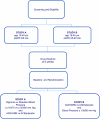The HALT polycystic kidney disease trials: design and implementation
- PMID: 20089507
- PMCID: PMC2801653
- DOI: 10.2215/CJN.04310709
The HALT polycystic kidney disease trials: design and implementation
Abstract
Background and objectives: Two HALT PKD trials will investigate interventions that potentially slow kidney disease progression in hypertensive autosomal dominant polycystic kidney disease (ADPKD) patients. Studies were designed in early and later stages of ADPKD to assess the impact of intensive blockade of the renin-angiotensin-aldosterone system and level of BP control on progressive renal disease. Design, settings, participants, and measurements: PKD-HALT trials are multicenter, randomized, double-blind, placebo-controlled trials studying 1018 hypertensive ADPKD patients enrolled over 3 yr with 4 to 8 yr of follow-up. In study A, 548 participants, estimated GFR (eGFR) of >60 ml/min per 1.73 m(2) were randomized to one of four arms in a 2-by-2 design: combination angiotensin converting enzyme inhibitor (ACEi) and angiotensin receptor blocker (ARB) therapy versus ACEi monotherapy at two levels of BP control. In study B, 470 participants, eGFR of 25 to 60 ml/min per 1.73 m2 compared ACEi/ARB therapy versus ACEi monotherapy, with BP control of 120 to 130/70 to 80 mmHg. Primary outcomes of studies A and B are MR-based percent change kidney volume and a composite endpoint of time to 50% reduction of baseline estimated eGFR, ESRD, or death, respectively.
Results: This report describes design issues related to (1) novel endpoints such as kidney volume, (2) home versus office BP measures, and (3) the impact of RAAS inhibition on kidney and patient outcomes, safety, and quality of life.
Conclusions: HALT PKD will evaluate potential benefits of rigorous BP control and inhibition of the renin-angiotensin-aldosterone system on kidney disease progression in ADPKD.
Figures
References
-
- U.S. Renal Data System: Annual Data Report: Atlas of Chronic Kidney Disease and End-Stage Renal Disease in the United States, Bethesda, MD, National Institutes of Health, National Institute of Diabetes and Digestive and Kidney Diseases, 2007
-
- Parfrey PS, Bear JC, Morgan J, Cramer BC, McManamon PJ, Gault MH, Churchill DN, Singh M, Hewitt R, Somlo S, et al. : The diagnosis and prognosis of autosomal dominant polycystic kidney disease. N Engl J Med 323: 1085–1090, 1990 - PubMed
-
- Gabow PA, Johnson AM, Kaehny WD, Kimberling WJ, Lezotte DC, Duley IT, Jones RH: Factors affecting the progression of renal disease in autosomal-dominant polycystic kidney disease. Kidney Int 41: 1311–1319, 1992 - PubMed
-
- Klahr S, Breyer JA, Beck GJ, Dennis VW, Hartman JA, Roth D, Steinman TI, Wang SR, Yamamoto ME: Dietary protein restriction, blood pressure control, and the progression of polycystic kidney disease. Modification of Diet in Renal Disease Study Group. J Am Soc Nephrol 5: 2037–2047, 1995 - PubMed
-
- Churchill DN, Bear JC, Morgan J, Payne RH, McManamon PJ, Gault MH: Prognosis of adult onset polycystic kidney disease re-evaluated. Kidney Int 26: 190–193, 1984 - PubMed
Publication types
MeSH terms
Substances
Grants and funding
- M01 RR000585/RR/NCRR NIH HHS/United States
- U01 DK062402/DK/NIDDK NIH HHS/United States
- DK62410/DK/NIDDK NIH HHS/United States
- UL1 RR025752/RR/NCRR NIH HHS/United States
- M01 RR000039/RR/NCRR NIH HHS/United States
- UL1 RR024992/RR/NCRR NIH HHS/United States
- DK62402/DK/NIDDK NIH HHS/United States
- DK62408/DK/NIDDK NIH HHS/United States
- UL1 TR000454/TR/NCATS NIH HHS/United States
- M01 RR000051/RR/NCRR NIH HHS/United States
- UL1 TR000448/TR/NCATS NIH HHS/United States
- U01 DK062411/DK/NIDDK NIH HHS/United States
- RR024150/RR/NCRR NIH HHS/United States
- RR025752/RR/NCRR NIH HHS/United States
- RR23940/RR/NCRR NIH HHS/United States
- RR00585/RR/NCRR NIH HHS/United States
- U01 DK062401/DK/NIDDK NIH HHS/United States
- DK62401/DK/NIDDK NIH HHS/United States
- UL1 RR025780/RR/NCRR NIH HHS/United States
- M01 RR000054/RR/NCRR NIH HHS/United States
- M01 RR023940/RR/NCRR NIH HHS/United States
- RR000054/RR/NCRR NIH HHS/United States
- U01 DK062408/DK/NIDDK NIH HHS/United States
- UL1 RR024150/RR/NCRR NIH HHS/United States
- RR000039/RR/NCRR NIH HHS/United States
- RR024992/RR/NCRR NIH HHS/United States
- UL1 RR025008/RR/NCRR NIH HHS/United States
- RR025780/RR/NCRR NIH HHS/United States
- DK62411/DK/NIDDK NIH HHS/United States
- U01 DK062410/DK/NIDDK NIH HHS/United States
- RR025008/RR/NCRR NIH HHS/United States
- RR000051/RR/NCRR NIH HHS/United States
LinkOut - more resources
Full Text Sources
Medical
Research Materials
Miscellaneous


